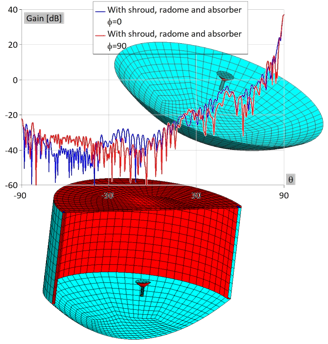Influence of Shroud, Absorber and Radome to Splash-plate Reflector
10-Sep-2018

10-Sep-2018
 Owing to the efficient implementation of method-of-moments, WIPL-D Pro EM software is able to solve electrically large reflector antennas (here, splash plate reflector antenna with shroud, absorber and radome) in dramatically small computational time at regular desktops or laptops. This is also efficiently shown in numerous application notes and reflector antenna guides available at the WIPL-D web site.
Owing to the efficient implementation of method-of-moments, WIPL-D Pro EM software is able to solve electrically large reflector antennas (here, splash plate reflector antenna with shroud, absorber and radome) in dramatically small computational time at regular desktops or laptops. This is also efficiently shown in numerous application notes and reflector antenna guides available at the WIPL-D web site.
In this application note, efficient WIPL-D simulations are briefly described by showing a basic splash plate reflector antenna with the shroud, reflector and the absorber. The antenna itself has feeder illuminating 35-lambda reflector (operating frequency is 16 GHz). The EM simulation of the feeder is advanced considering the shape of the splash plate and the dielectric support included. Such simulation can be run in seconds at any modern laptop or desktop.
As an advanced level of reflector antenna simulation, the antenna is modified by adding metallic shroud, which is then covered with the dielectric absorber. In the final step, a simple flat radome is added to cover the aperture.
The results indicate the dramatic effect of the shroud to front to back ratio. Adding absorber further improves front to back for another 10 dB, but such lossy material reduces the gain for 0.8 dB. Theoretically maximally transparent radome does not compromise the gain and front to back ratio.
All models are simulated at the regular desktop PC equipped with single inexpensive GPU card. With WIPL-D software, this transforms the regular desktop into powerful workstation. The simulation times are rather low.
Section: Reflector Antennas
For full version of the document, please check the following pdf.